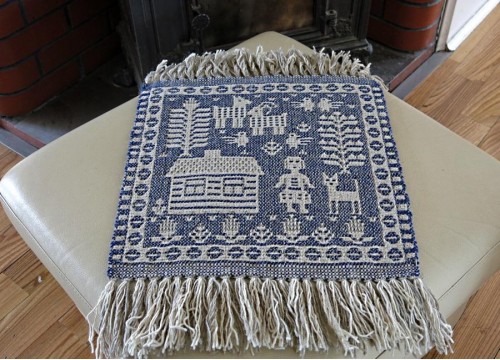
| You have no items in your shopping cart |
Transportation cost: Poland: 14 - 16 zł, Worldwide: from 22 zł

| You have no items in your shopping cart |
Tapestry, manufactured with application of traditional dual-warp weaver’s craft technology and XIX-century old looms. It can be used as a coverlet for chair or bench or wall decoration. This tapestry depicts a pair of cocks and a tree of life. Particularly noteworthy is the color of the fabric, the bottom part of which was made of wool of a different shade than its upper part. Owning to application of dual-warp weaver’s craft technology, this fabric can be presented from its both sides. Dual-warp weaver’s craft poses one of the most interesting and original traditions in Polish folk art. Although formerly this type of weaver’s craft was popular in whole Europe, to this day it preserved only in North-East Poland, Spain, Sweden and Italy. Therefore presented fabrics pose true one-offs.
Weaving is one of the oldest crafts. In the past every house was equipped with a weaving workshop. Women occupied themselves more frequently with it than men. They made parts of attire, fabrics necessary for household use and for interior decoration. Natural materials were used in the Polish weaving sourced from and processed on their own household and farm: linen, wool and hemp. Double-warped weaving is one of the most interesting and most original traditions in Polish folk art. The origin of double-warped weaving is unclear. It arises controversies to this day. Outside of Europe this weaving type can be found solely in Mexico and Peru. Although weaving used to be popular Europe-wide in the past, it has been preserved exclusively in northern-east Poland, Spain, Sweden and Italy. Double-warped weaving has stood the test of time only in one centre in Poland – in Janów Podlaski.
 Mrs Filomena is an outstanding Janów weaver who received numerous awards in weaving competitions. She learnt a double-warped technique from her mother-in-law. She has been weaving for 30 years. Today she works at her grandmother’s loom which has been preserved since the XIXth century. That is what she says about her craft: ‘A carpet or a cover manufacturing starts from …… a sheep. Animals have to be shorn, wool is washed and cleaned, and appropriately prepared so that it is ready for spreading over a wooden loom, it also has to be dyed. Colours are chosen at a weaver’s discretion. Patterns can be divided into traditional and theme-based ones. The former cover vegetable motifs, the latter represent scenes of engagement, a forest clearing or a countryside playground. I, myself wove an army motif representing rockets for a competition’. (‘Weaving matters’).Real works of art can be admired at Mrs Filomena’s house – some of them can include family memorabilia that have remained from the war times. Mrs Filomena points to one of them and says: ‘I will not make you such a rug nowadays’ – those dyes are no longer available’.
Mrs Filomena is an outstanding Janów weaver who received numerous awards in weaving competitions. She learnt a double-warped technique from her mother-in-law. She has been weaving for 30 years. Today she works at her grandmother’s loom which has been preserved since the XIXth century. That is what she says about her craft: ‘A carpet or a cover manufacturing starts from …… a sheep. Animals have to be shorn, wool is washed and cleaned, and appropriately prepared so that it is ready for spreading over a wooden loom, it also has to be dyed. Colours are chosen at a weaver’s discretion. Patterns can be divided into traditional and theme-based ones. The former cover vegetable motifs, the latter represent scenes of engagement, a forest clearing or a countryside playground. I, myself wove an army motif representing rockets for a competition’. (‘Weaving matters’).Real works of art can be admired at Mrs Filomena’s house – some of them can include family memorabilia that have remained from the war times. Mrs Filomena points to one of them and says: ‘I will not make you such a rug nowadays’ – those dyes are no longer available’.
No customer reviews for the moment.
















